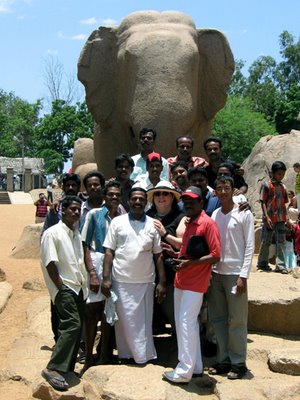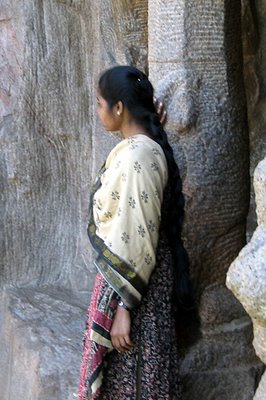Mamallapuram II
There was a time when the British were dominating India when they would stumble upon great and ancient ruins and ask the locals what they were and the locals would say they did not know. Half the time the locals hadn't even known the ruins were there, as large sections of them had been devoured by the wilderness and people thought of them only as sources of stone or a place where snakes bred. It was a common occurrence that a foreign commentator would remark that the Indians did not know, or seem to care, about their own history.
This was wrong in many ways, of course, as the Indians just cared about a different kind of history than that about which the Europeans were asking them. But for a long time under the Imperial yoke there was a sense in many parts of India that their own history was less important, less spectacular than that of others. Even into the years of Congress and Independence it was often a complaint from the educated elite of India that the common Indian had little sense of pride or history, little ownership in the past and thus little ownership in the future.
This weekend in Mamallapuram among the ancient temples and rock cut sculptures it was very crowded, and finding a place to stand still for long inside any of the temples could be a challenge. Some of the pictures that I took, especially of the Krsna temple, took quite a lot of waiting to get a moment when there was not a throng of people in the frame. And of all these thronging tourists, come eagerly to gape and gawk and the ruins of ancient splendor, there was barely a handful of faces that weren't those of India. There was an older Japanese couple, two Canadians that we all know and love, some backpacking Australians, and a bare handful of Americans. The rest of the crowd was Indian. They were there from Chennai and Mumbai and Dehli and Varanasi and Banglore and Gujarat. There were brahmins who had to get special parking for their Mercedes SUVs, farmers who came in hanging off the side of a beaten old buss, school tours full of children barely old enough to comprehend what they were seeing, and elderly renunciates come to spend their end years in among the relics.

Not only where they there, and in numbers and diversity, but they were there with pride. Any time I would stop to look in my Lonely Planet guide (because I was looking for a place to eat, mostly) someone would stop next to me and start to explain the history of the nearest monument. They would tell me of the Palavas and the Cholas and the Mughals and the coming and going of the British. Many were surprised when they found that I already knew something of these matters, but some just took it as a due. People should know about these things because they are important.
India, it seems, has a sense of itself. A sense of purpose and place. A sense of history. But the sense of the future… that is the sticky wicket, as it always is.
The same weekend that we were in Mamallapuram being told about the rise and fall of dynasties there were meetings happening all over India to determine the country's future. This last Tuesday was Independence Day, you see, and so there was a great commotion as people got ready to celebrate and to work to ensure that India became the country that they want it to be.
As part of these preparations there was a conference in our hotel in which members of various political and social groups got together to talk about their combined platforms. Among the things they wanted to do were increasing literacy and newspaper readership, give away TVs so that people will watch the news and the western media, and to oppose recent court decisions saying that only Brahmins can be priests. They want to spread the word about condoms and let young women think that it is alright to have sex before marriage as long as they are safe. They want to remove superstitions and replace them with scientific thought and close down the colleges of Vedic studies and open more seats in bioengineering colleges.

In Andhra Pradesh there was another meeting in which the heads of state agreed that it was best to not spend more money in order to increase westernized universities, but to start partly subsidizing ashrams as places of religious education while simultaneously increasing the backing of Vedic colleges. They issued a letter of support for the courts decision that only brahmins could be priests, and praised their people for resisting westernized media penetration.

But opposite as these meetings were, they were not the worst. They were both carried out with civil decorum and a sense of order. There were other meetings that did not go so well. A civil liberties union meeting in Rajastan was stormed by "nationalist" thugs who beat and intimidated the activists, screaming that their words were sedition and were intended to weaken the country. Local universities braced for more protests and possible violence over the possibility of state-mandate affirmative action programs that reserve a number of seats for low caste and tribal students. And Delhi was turned into a no-fly zone as multiple credible threats of terrorist activity were logged – and many of those were not international threats, but terrorists from in-house organizations. At least three artists were forced to flee the country that created the kama sutra for having the gall to make paintings of goddesses naked, and a woman was given a medal of award for her long work in making the sex trade more respected. Oh, and there was a school blown up in Sri Lanka because the government thought it might be a Tamil Tiger training base.
India has a sense of herself, and a sense of her past. But sometimes it seems like she might tear herself apart as she decides who she is going to be in the future. Even being here I don't get a full sense of what India is or who she will become.

This was wrong in many ways, of course, as the Indians just cared about a different kind of history than that about which the Europeans were asking them. But for a long time under the Imperial yoke there was a sense in many parts of India that their own history was less important, less spectacular than that of others. Even into the years of Congress and Independence it was often a complaint from the educated elite of India that the common Indian had little sense of pride or history, little ownership in the past and thus little ownership in the future.
This weekend in Mamallapuram among the ancient temples and rock cut sculptures it was very crowded, and finding a place to stand still for long inside any of the temples could be a challenge. Some of the pictures that I took, especially of the Krsna temple, took quite a lot of waiting to get a moment when there was not a throng of people in the frame. And of all these thronging tourists, come eagerly to gape and gawk and the ruins of ancient splendor, there was barely a handful of faces that weren't those of India. There was an older Japanese couple, two Canadians that we all know and love, some backpacking Australians, and a bare handful of Americans. The rest of the crowd was Indian. They were there from Chennai and Mumbai and Dehli and Varanasi and Banglore and Gujarat. There were brahmins who had to get special parking for their Mercedes SUVs, farmers who came in hanging off the side of a beaten old buss, school tours full of children barely old enough to comprehend what they were seeing, and elderly renunciates come to spend their end years in among the relics.

Not only where they there, and in numbers and diversity, but they were there with pride. Any time I would stop to look in my Lonely Planet guide (because I was looking for a place to eat, mostly) someone would stop next to me and start to explain the history of the nearest monument. They would tell me of the Palavas and the Cholas and the Mughals and the coming and going of the British. Many were surprised when they found that I already knew something of these matters, but some just took it as a due. People should know about these things because they are important.
India, it seems, has a sense of itself. A sense of purpose and place. A sense of history. But the sense of the future… that is the sticky wicket, as it always is.
The same weekend that we were in Mamallapuram being told about the rise and fall of dynasties there were meetings happening all over India to determine the country's future. This last Tuesday was Independence Day, you see, and so there was a great commotion as people got ready to celebrate and to work to ensure that India became the country that they want it to be.
As part of these preparations there was a conference in our hotel in which members of various political and social groups got together to talk about their combined platforms. Among the things they wanted to do were increasing literacy and newspaper readership, give away TVs so that people will watch the news and the western media, and to oppose recent court decisions saying that only Brahmins can be priests. They want to spread the word about condoms and let young women think that it is alright to have sex before marriage as long as they are safe. They want to remove superstitions and replace them with scientific thought and close down the colleges of Vedic studies and open more seats in bioengineering colleges.

In Andhra Pradesh there was another meeting in which the heads of state agreed that it was best to not spend more money in order to increase westernized universities, but to start partly subsidizing ashrams as places of religious education while simultaneously increasing the backing of Vedic colleges. They issued a letter of support for the courts decision that only brahmins could be priests, and praised their people for resisting westernized media penetration.

But opposite as these meetings were, they were not the worst. They were both carried out with civil decorum and a sense of order. There were other meetings that did not go so well. A civil liberties union meeting in Rajastan was stormed by "nationalist" thugs who beat and intimidated the activists, screaming that their words were sedition and were intended to weaken the country. Local universities braced for more protests and possible violence over the possibility of state-mandate affirmative action programs that reserve a number of seats for low caste and tribal students. And Delhi was turned into a no-fly zone as multiple credible threats of terrorist activity were logged – and many of those were not international threats, but terrorists from in-house organizations. At least three artists were forced to flee the country that created the kama sutra for having the gall to make paintings of goddesses naked, and a woman was given a medal of award for her long work in making the sex trade more respected. Oh, and there was a school blown up in Sri Lanka because the government thought it might be a Tamil Tiger training base.
India has a sense of herself, and a sense of her past. But sometimes it seems like she might tear herself apart as she decides who she is going to be in the future. Even being here I don't get a full sense of what India is or who she will become.




3 Comments:
The photos are beautiful. Keep them coming.
I have to say, your writing has been fantastic -- and very polished. It almost leads me to suspect you're going to try to sell these to a magazine or something. If not, you should think about it.
(It also leads me to suspect you have a little too much time on your hands!)
Thanks both of you.
I should note that Mo takes most of the pictures. I suck with a camera.
Post a Comment
<< Home